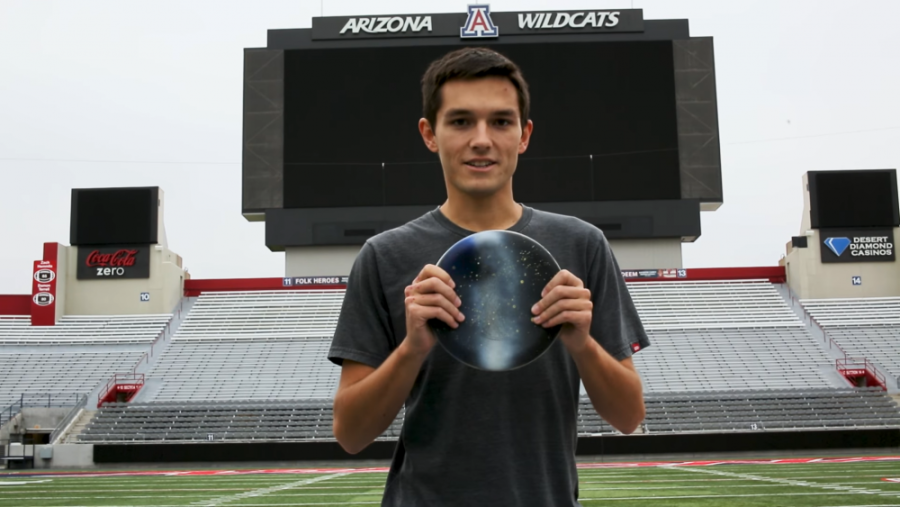Six students are running around on the University of Arizona football stadium field with a camera, sound equipment and some frisbees. These students are part of the Active Galactic Videos (AGV) team, and they are turning the stadium into a scale model of the universe.
Alejandro Olmedo, a film and television junior, weaves through the stands, trying to find the perfect shot of the entire field. Down on the field, Aidan Gibbs, a senior studying astronomy and physics, carefully measures out the distances between a couple frisbees that had been spray painted to look like galaxies.
The filming was for a YouTube video, one of many populating the Active Galactic Videos channel on YouTube, titled “Our Galaxy as a Frisbee — Size of the Visible Universe.” It was shot back in December and released early this semester on the channel, which now has over 6,000 subscribers.
AGV is a student group based at the UA Steward Observatory that creates astronomy videos for community education. The group is run by Chris Impey, a distinguished professor of astronomy and the associate dean of the UA College of Science, and managed by Matthew Wenger, an educational program manager at Steward Observatory.
The whole project began several years back when Wenger was hired at Steward Observatory to assist Impey with a new astronomy course.
RELATED: UA seniors ‘Dream in Widescreen’
“I started working for [Impey] and the department with the goal of developing these massive, open, online courses,” Wenger said. “We had another student, Carmen, who was working with us, and one of the things we had talked about doing was coming up with supplementary instructional videos to go along with the course, and the idea was to start a YouTube video about astronomy.”
From there, Impey and Wenger began building the team with a few more astronomy undergraduates, and once they received a grant to continue the project, more students were brought on and the team took on the AGV name.
“As the project grew and the team grew, it became necessary to have different talents in the mix,” Impey said. “Rather than having a couple astronomy and physics majors doing everything, we were able to recruit people who are videographers; we’ve had music majors to help us with sound; we have journalism students [and] English majors.”
The current makeup of the AGV team is approximately half astronomy, physics or other science majors and half majors of other sorts, including those Impey mentioned. Students collaborate on all the videos and bring their backgrounds and skills to each project in order to produce the “most high-quality content possible.”
While the AGV team and the YouTube channel has grown since its humble beginnings, it’s not yet reached the realm of popular video education channels like SciShow or TED. Despite smaller numbers, however, the AGV team has created videos over the years that have garnered a significant amount of attention for an educational student group, one of the first being a music video for a song about the H-R diagram.
“I got to explore something that I like to do,” said Calahan, the writer and singer of the H-R diagram song, about the graphical tool that astronomers use to classify stars. “I don’t really know any other context where I’d be able to write science music videos. Everyone was really supportive and we got to jump around Steward a lot and be really silly.”
“The H-R Diagram Song” was released back in January of 2016. With over 17,500 views since it was first published, it is one of AGV’s most frequented videos and one that first started to build interest in the channel.
RELATED: Wildcats take over the catwalk
The team had the opportunity to work with popular British YouTuber Tom Scott, collaborating with him by creating a video about the Richard F. Caris Mirror Lab here at the UA. The lab creates mirrors for the Giant Magellan Telescope being built in Chile, and the video, hosted by Calahan and Melissa Thomas, a senior studying astronomy, geology and physics, delves into the mirror-making process and history.
The video has been viewed over 294,000 times, and its original release directed a wave of traffic to the AGV channel back on Jan. 1. The boost inspired the AGV team to continue creating more high-quality educational content to satisfy and grow their new audience.
The goal of AGV is to provide the students in it an opportunity to develop their professional and collaborative skills.
“[AGV] gives us an opportunity to work on stuff we wouldn’t normally work on,” Gibbs said. “In astronomy we like to do outreach, but for most of us, that’s usually working the telescope or being a TA, but this is definitely different; a lot of places don’t have this opportunity.”
Those interested in learning a little more about astronomy from some passionate students can check out the AGV YouTube channel. The team uploads about every two weeks and their video backlog has more than 60 videos on a range of topics, so there’s always something new to learn.
Follow Victoria Pereira on Twitter









